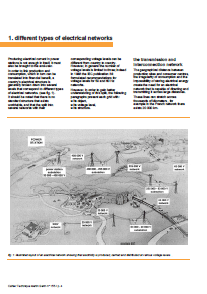Transfer of electrical energy
In a country, the Transmission and Public Distribution networks ensure the transfer of electrical energy from points of production to consumer units. The points of production are power stations that generate electrical energy from various primary energy sources (nuclear, hydro-electric, coal….) The points of consumption in MV – Medium Voltage -, are substations, from which the energy is delivered to customers (subscribers).
This takes place via the “MV distribution system “wich is the object of this “Cahier Technique“ report. In this “Cahier Technique“ report, after having described the various types of distribution networks and the distributor’s role, the reader who is not familiar with MV will find details on:
- topologies of MV networks,
- substations,
- protection and telecontrol devices.
Comment: In this “Cahier Technique“ report, the term MV applies to any voltage from a few kV to 40 kV.
Different types of electrical networks
Producing electrical current in power stations is not enough in itself, it must also be brought to the end-user. In order to link production and consumption, which in turn can be translated into financial benefit, a country’s electrical structure is generally broken down into several levels that correspond to different types of electrical networks.
It should be noted that there is no standard structure that exists worldwide, and that the split into several networks with their corresponding voltage levels can be
different from country to country. However, in general the number of voltage levels is limited to three; indeed in 1983 the IEC publication 38 formulated recommendations for voltage levels for 50 and 60 Hz networks.
However, in order to gain better understanding of this split, the following paragraphs present each grid with:
- its object,
- its voltage level,
- its structure.
The transmission and interconnection network
The geographical distance between production sites and consumer centres, the irregularity of consumption and the impossibility of storing electrical energy create the need for an electrical network that is capable of directing and transmitting it across large distances. These lines can stretch across thousands of kilometers , for example in the French network there exists 20 000 km.
AUTHOR: Schneider Electric expert | Christian PURET
| Title: | MV public distribution networks throughout the world |
| Format: | |
| Size: | 0.25MB |
| Pages: | 28 |
| Download: | Right here | Video Courses | Membership | Download Updates |


